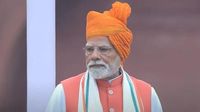On August 15, 2025, India’s Red Fort was once again the stage for a major policy announcement as Prime Minister Narendra Modi delivered his Independence Day address, setting out an ambitious vision for the country’s energy future. Against the backdrop of rising household electricity costs and a shifting global energy landscape, Modi’s remarks pointed to a sweeping transformation—one that would not only empower ordinary Indians to cut their power bills but also reshape the nation’s energy portfolio through dramatic expansion of nuclear power and new opportunities for private investment.
For millions of families across India, the struggle to manage monthly electricity bills is all too familiar. According to NDTV, even a modest increase of 100 units in monthly usage can push a household into a higher tariff bracket, adding Rs 1,000 or more to their bill. Energy experts say that targeted changes in how homes use power—such as swapping out old ceiling fans for energy-efficient BLDC models, switching to LED lighting, maintaining water motors, and optimizing air conditioner settings—can make a world of difference. Not only do these practical steps ease financial pressure, but they also contribute to lower overall power consumption and a reduced environmental footprint.
But while individual households are doing their part to rein in costs, the government is taking aim at the bigger picture. In his address, Prime Minister Modi declared, “We know that we remain dependent on many countries to meet our energy needs. But to build a truly self-reliant India, we must achieve energy independence.” His words underscored a growing sense of urgency: as India’s economy booms and its population grows, so does the demand for reliable, affordable power.
Modi’s speech highlighted the remarkable progress India has already made in renewable energy. “India’s solar energy capacity has grown thirtyfold in the past eleven years,” he noted, pointing to a dramatic shift in how the country generates electricity. The construction of new dams and the rapid expansion of solar projects have put India on the map as a leader in clean energy. Still, as the Prime Minister acknowledged, renewables alone won’t be enough to meet the country’s soaring energy needs.
That’s where nuclear power comes in. In a move that signals a major policy shift, Modi announced that India is now “focusing actively on nuclear energy,” with 10 new nuclear reactors already operational. The government’s goal is nothing short of transformative: by the time India celebrates the 100th anniversary of its independence in 2047, it aims to increase its nuclear energy capacity tenfold. According to News18, the target is even more ambitious—a twelvefold increase in nuclear power generation capacity by 2047. If these targets are met, nuclear power would account for about 5% of India’s total electricity supply, a significant jump from current levels.
But the push for nuclear isn’t just about building more reactors. For decades, India’s nuclear sector has been tightly controlled by the state, with exclusive authority over uranium mining, imports, and processing. This monopoly was rooted in concerns about the potential misuse of nuclear materials, radiation safety, and national security. Now, Modi’s government is preparing to open up parts of the sector to private participation, aiming to attract billions of dollars in investment and accelerate industry growth. As the Prime Minister put it, “Reform is a continuous process… We have introduced significant changes in the nuclear energy sector. The field of nuclear energy has now been opened up to the private sector.”
Reuters reports that the government is easing rules to allow foreign players to take minority stakes in nuclear power plants, a move designed to bring in new capital and expertise. While the state will retain control over the reprocessing of spent uranium and the management of plutonium waste—consistent with global norms—a new regulatory framework will enable private Indian firms to mine, import, and process uranium. This is seen as a crucial step to meet the expected surge in fuel demand as nuclear capacity expands.
For many, the significance of this policy shift can’t be overstated. Ending the decades-old state monopoly over the nuclear sector marks a turning point, one that could unlock new opportunities for innovation, job creation, and economic growth. Proponents argue that opening the door to private and foreign investment will help India leapfrog technological barriers and build a robust, diversified energy portfolio. Critics, however, caution that the move must be managed carefully, with strict oversight to ensure safety, security, and transparency.
Meanwhile, on the home front, the government’s push for energy efficiency is dovetailing with grassroots efforts to reduce power consumption. As NDTV highlights, simple upgrades—like installing BLDC ceiling fans, switching to LED bulbs, and keeping water motors in good repair—can save households more than 100 units of electricity each month. These savings are not just a boon for family budgets; they also help the country as a whole reduce its reliance on imported fuels and cut carbon emissions.
It’s a story of change happening at every level, from the corridors of power in New Delhi to the living rooms and kitchens of ordinary Indians. The government’s vision is bold: to build a self-reliant, energy-secure nation that harnesses the full potential of its people and its resources. But realizing that vision will require more than just policy pronouncements and investment pledges. It will demand a sustained commitment to reform, innovation, and collaboration—across sectors, regions, and communities.
As India looks ahead to 2047 and the centenary of its independence, the stakes could hardly be higher. Energy independence is not just a matter of national pride; it’s a prerequisite for economic growth, environmental sustainability, and social progress. Whether through the quiet hum of an efficient ceiling fan or the controlled power of a nuclear reactor, the choices made today will shape the lives of generations to come.
For now, the message from the Red Fort is clear: India is ready to chart a new course—one that puts power, quite literally, in the hands of its people.
